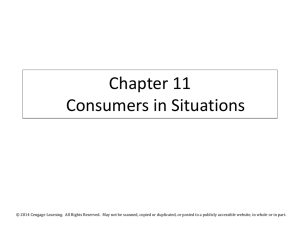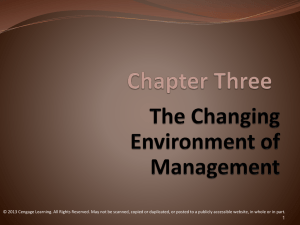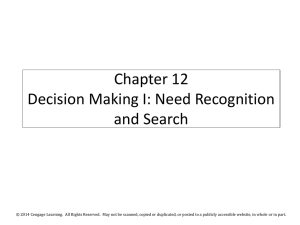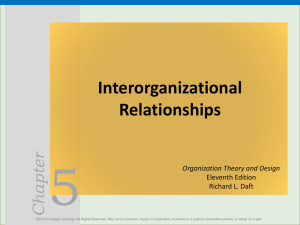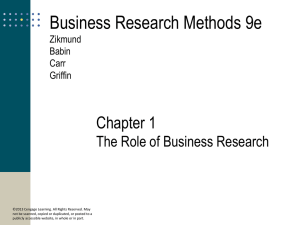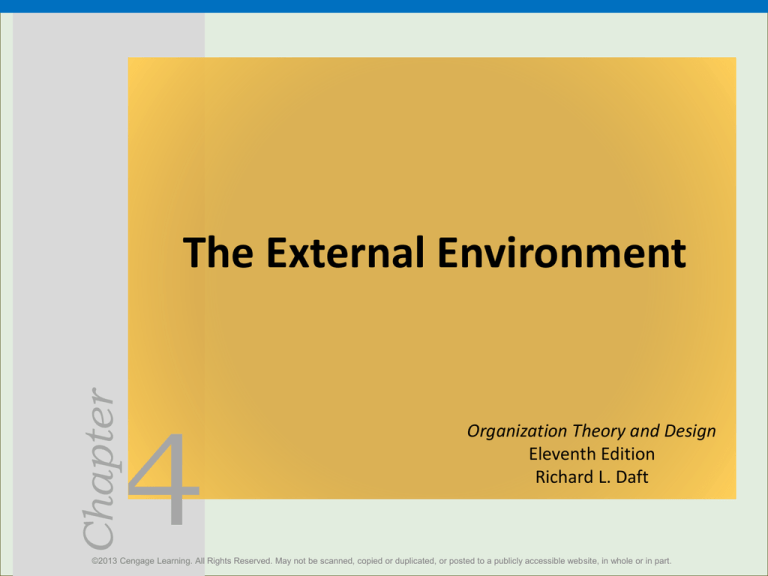
Chapter
The External Environment
4
Organization Theory and Design
Eleventh Edition
Richard L. Daft
©2013 Cengage Learning. All Rights Reserved. May not be scanned, copied or duplicated, or posted to a publicly accessible website, in whole or in part.
The Organization Environment
• All the elements that exist outside the
boundary of the organization
• Potential to affect all or part of the
organization
– Domain is the chosen environmental field of
action
– Sectors or subdivisions that contain similar
elements
2
©2013 Cengage Learning. All Rights Reserved. May not be scanned, copied or duplicated, or posted to a publicly accessible website, in whole or in part.
An
Organization’s
Environment
©2013 Cengage Learning. All Rights Reserved. May not be scanned, copied or duplicated, or posted to a publicly accessible website, in whole or in part.
The Task Environment
Sectors that the organization interacts with
directly to achieve goals
– Typically the “industry” and market sectors
– Human Resources
– International Sector
– Raw Materials Sector
4
©2013 Cengage Learning. All Rights Reserved. May not be scanned, copied or duplicated, or posted to a publicly accessible website, in whole or in part.
General Environment
• Sectors that might not have a direct impact on
the daily operations of a firm
– Government sector: regulation
– Sociocultural sector: the green movement
– Economic conditions: global recession
– Technology sector: massive and constant changes
– Financial resources
• Extremely important to entrepreneurs
5
©2013 Cengage Learning. All Rights Reserved. May not be scanned, copied or duplicated, or posted to a publicly accessible website, in whole or in part.
International Environment
• Can directly affect many organizations
• Has grown in importance
• Distinction between foreign and domestic
operations
• All organizations face domestic and global
uncertainty
6
©2013 Cengage Learning. All Rights Reserved. May not be scanned, copied or duplicated, or posted to a publicly accessible website, in whole or in part.
The Changing Environment
• The dimensions of the environment range:
– Unstable
– Homogeneous
– Heterogeneous
– Simple
– Complex
Organizations must cope
with and manage
uncertainty to be effective.
• The dimensions boil down to:
– The need for information about the environment
– The need for resources from the environment
7
©2013 Cengage Learning. All Rights Reserved. May not be scanned, copied or duplicated, or posted to a publicly accessible website, in whole or in part.
Dimensions of the Environment
• Simple-complex: heterogeneity; the number
of dissimilarity of external elements
• Stable-Unstable: whether elements in the
environment are dynamic
8
©2013 Cengage Learning. All Rights Reserved. May not be scanned, copied or duplicated, or posted to a publicly accessible website, in whole or in part.
Framework for Assessing
Environmental Uncertainty
9
©2013 Cengage Learning. All Rights Reserved. May not be scanned, copied or duplicated, or posted to a publicly accessible website, in whole or in part.
Adapting to a Changing Environment
• Organizations need the right fit between
internal structure and the external
environment
– Adding Positions and Departments
– Building Relationships
• Boundary-spanning roles
• Business intelligence
– Differentiation and Integration
– Organic vs. Mechanistic Management Process
– Planning, Forecasting, and Responsiveness
10
©2013 Cengage Learning. All Rights Reserved. May not be scanned, copied or duplicated, or posted to a publicly accessible website, in whole or in part.
Organizational Departments Differentiate to
Meet Needs of Sub-environments
11
©2013 Cengage Learning. All Rights Reserved. May not be scanned, copied or duplicated, or posted to a publicly accessible website, in whole or in part.
Different Goals and Orientations
among Departments
12
©2013 Cengage Learning. All Rights Reserved. May not be scanned, copied or duplicated, or posted to a publicly accessible website, in whole or in part.
Environmental Uncertainty and
Organizational Integrators
13
©2013 Cengage Learning. All Rights Reserved. May not be scanned, copied or duplicated, or posted to a publicly accessible website, in whole or in part.
Mechanistic and Organic Forms
• Tasks are specialized
• Tasks are rigidly defined
• Strict hierarchy of authority
and control
• Knowledge and control of
tasks are centralized
• Communication is vertical
• Employees contribute to the
common task of the
department
• Tasks are adjusted and
redefined through teamwork
• Less hierarchy of authority
and control
• Knowledge and control of
tasks are located anywhere in
the organization
• Communication is horizontal
14
©2013 Cengage Learning. All Rights Reserved. May not be scanned, copied or duplicated, or posted to a publicly accessible website, in whole or in part.
Contingency Framework for Uncertainty and
Organizational Responses
15
©2013 Cengage Learning. All Rights Reserved. May not be scanned, copied or duplicated, or posted to a publicly accessible website, in whole or in part.
Dependence on External Resources
Resource-dependence perspective means
organizations depend on the environment
– Strive to acquire control over resources to
minimize dependence
– Organizations are vulnerable if resources are
controlled by other organizations
– Minimize vulnerabilities
– Will team up with others when resources are
scarce
16
©2013 Cengage Learning. All Rights Reserved. May not be scanned, copied or duplicated, or posted to a publicly accessible website, in whole or in part.
Influencing External Resources
• Balance linkages and independence
• Reach out and change or control elements in
the environment
1. Establish favorable relationships with key elements
of the environment
2. Shape the environment by influencing key sectors
17
©2013 Cengage Learning. All Rights Reserved. May not be scanned, copied or duplicated, or posted to a publicly accessible website, in whole or in part.
Organizing Strategies for Controlling
the External Environment
18
©2013 Cengage Learning. All Rights Reserved. May not be scanned, copied or duplicated, or posted to a publicly accessible website, in whole or in part.
Environmental Characteristics and
Organizational Actions
19
©2013 Cengage Learning. All Rights Reserved. May not be scanned, copied or duplicated, or posted to a publicly accessible website, in whole or in part.
Design Essentials
Change and complexity have major implications for
organizations
Organizational environment differs regarding uncertainty and
resource dependence
The goal for organizations is managing efficiencies and
survival
Managers must understand how the environment influences
the structure of an organization
When risk is great, organizations can attempt to change or
influence the environment
Organizations can learn and adapt to the environment
20
©2013 Cengage Learning. All Rights Reserved. May not be scanned, copied or duplicated, or posted to a publicly accessible website, in whole or in part.


